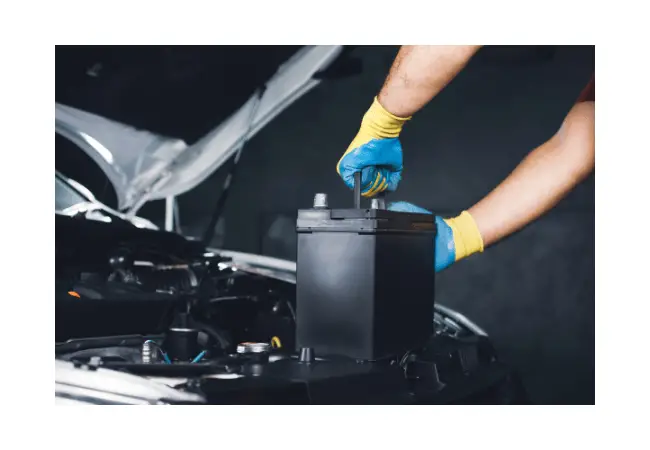While the average car battery lifespan is about three to five years, depending on how you drive, replacing it every few years is recommended as part of routine maintenance.
In the world of automotive maintenance, few tasks are as commonplace and essential as changing a car battery. Whether you’re an experienced gearhead or a novice driver, understanding the ins and outs of this process can save you time, money, and headaches down the road. One of the most common inquiries in this realm revolves around the timeframe required for this seemingly straightforward task. “How long does it take to change a car battery?” is a question that often comes to mind, and in this article, we’ll delve into the various factors that can influence the duration of this vital automotive chore.
Changing a car battery may seem like a quick and straightforward task, but it’s important to remember that several variables can affect the overall time it takes to complete the job. Whether you’re tackling this project on your own or seeking the assistance of a professional mechanic, understanding the process’s nuances is crucial.
The answer to the question, “How long does it take to change a car battery?” is not a one-size-fits-all proposition. It can vary significantly depending on factors such as your level of experience, the type of vehicle you drive, and the specific tools at your disposal. However, on average, a skilled individual can typically swap out a car battery in as little as 15 to 30 minutes. For those new to the task, it may take closer to 45 minutes to an hour.
Keep in mind that if you encounter any unforeseen challenges, such as corroded terminals or stubborn fasteners, the process can extend beyond these estimates. In any case, being prepared and having the necessary tools and know-how will make the task smoother and more efficient, ensuring you get back on the road with a reliably functioning vehicle.
Whether you’re changing car batteries for routine maintenance, after recognizing the signs of a dying battery, or after it died, the common question is how long does it take to change a car battery?
Jump To
- 1 Warning Signs Your Car Battery Needs Replacing
- 1.1 Check-Engine Light or Battery Light Is ON
- 1.2 Dim Lights and Electronic Failure
- 1.3 Slow Engine Crank
- 1.4 Corroded Connectors
- 1.5 Gas Leakage
- 1.6 Misshapen Battery Case
- 1.7 Benefits of Replacing a Car Battery
- 1.8 How Long Does It Take to Change a Car Battery?
- 1.9 What to Do if the Battery Goes Dead?
- 1.10 How Much Does It Cost to Change a Car Battery?
- 1.11 Battery Selection Tips
- 1.12 Battery Type
- 1.13 Cold-Cranking Amps (CCA) Rating
- 1.14 Group Number
- 1.15 How Often Does a Car Require a New Battery?
- 1.16 Frequently Asked Questions
Warning Signs Your Car Battery Needs Replacing

Before you go to replace a car battery, always test the battery by measuring its voltage with a battery tester or multimeter. If the reading on the multimeter is less than 11 Volts, it’s time to get the old battery replaced.
It is essential to recognize the symptoms of dying car batteries. Here are the common signs that indicate you need to get your battery tested and replaced soon.
Check-Engine Light or Battery Light Is ON
While modern cars come equipped with a battery warning light to indicate when the old battery is low, the cars that don’t have a separate battery light will have a check engine light for the same purpose.
Your car’s electrical system reads voltages, and voltage drops across the car’s components.
A bad battery doesn’t provide the primary source of voltage for the components to run correctly. The Electronic Control Unit (ECU) reads a fault and turns on the check engine light or battery replacement light.
Take your car to a service center for a quick battery charge test taking care of. Getting the battery replaced takes about the same time as diagnosing the problem. You can also use a trickle charger overnight to get the voltage up if your battery is low.
Dim Lights and Electronic Failure

An old battery or one that needs replacement won’t be able to power up the car’s electrical systems like the accessories, lights, etc.
If your car’s headlights, dashboard lights or interior lights are flickering or dimmer than usual, it implies a weak battery that isn’t able to keep your vehicle’s electrical system running properly and keep the lights stable simultaneously.
Slow Engine Crank
If your car doesn’t start immediately upon turning the ignition key or pressing the ignition button, it’s time to replace the battery.
When the battery cannot produce sufficient power, either the engine doesn’t start at all or takes time to start.
Corroded Connectors

Corrosion or oxidation of the old battery terminals happens with the overcharge of a bad battery. The battery acid gets out of the battery case and gets contaminated (visible as white ashes or corrosion on the battery terminal). Use baking soda to help neutralize the corrosion around each battery terminal or the hold-down strap to prevent this problem with battery cables.
You should also keep a close watch on the condition of the metal tray that your battery sits on. It may start to corrode and rust away allowing your battery to fall.
Gas Leakage
Gas leaking out of a battery results from chemical reactions inside the battery with an internal short or damage. Any rotten smell from the car hood is most likely an indication of a battery requiring replacement.
Misshapen Battery Case
Any bulging or misshapen battery on one or more sides indicates internal damage to car batteries and can lead to a dangerous situation if not replaced immediately.
Benefits of Replacing a Car Battery

Replacing car batteries as part of routine maintenance helps your car run better and last longer. Some of the benefits include the following:
- A battery exchange prevents you from having to go for an entire engine replacement.
- A new battery helps in the engine’s smooth running and maintains your car’s stability (helping save money and time in the long run).
- Replacing a battery improves your car’s range, providing it with more power when needed to ensure it can travel farther.
- A new battery helps prevent fires.
How Long Does It Take to Change a Car Battery?
If you take your car to an authorized service center, it’ll take about 15 – 30 minutes to install a new battery.
However, the actual time to change a car battery depends on the car model, the ease of access, and how effortlessly you can remove the old battery from the car. Replacing car batteries can take anywhere from 30 minutes to an hour.
If you’re replacing your car battery by yourself, it could take longer than it would for an experienced mechanic, especially the first time around.
What to Do if the Battery Goes Dead?
To prevent your car battery from dying, first, remove any obstructions from the battery terminals (any plastic or metal obstructing the electrical connections).
Next, discharge the battery by opening an airtight container and breathing in deeply to remove all the air from the cells. Pour sufficient cold water on each cell, close the container, and place it back on the charger.
The heat from the water causes the discharge of the cells in car batteries.
How Much Does It Cost to Change a Car Battery?
Depending on the quality, brand, size, and power of the replacement car battery, it can cost anywhere between $45 – $250 at most auto parts stores.
A battery exchange for most car batteries is a relatively simple task that isn’t time-consuming, the significant expense stems from purchasing the new battery.
Battery Selection Tips
Ensure you select the correct battery by consulting the car owner’s manual or a mechanic. If you install an incorrect battery, your car’s electrical system could be adversely affected, possibly creating a short circuit with nearby components or a dead battery.
Some important factors that ensure a proper battery fit and functioning include the battery’s physical size, type, terminal configuration, and amp-hour (Ah) rating or cold-cranking amps (CCA).
Battery Type

Most cars use conventional lead-acid batteries, while some models use highly spill-resistant AGM batteries (that handle repeated charging and discharging better in cars with stop-start engine systems).
Always replace using the same type of battery that came in the car (when you newly purchased it) since charging systems are optimized for the battery type.
Cold-Cranking Amps (CCA) Rating
How much electrical power a battery can provide at zero degrees Fahrenheit is given by its CCA rating. The battery power ratings could also be stated in an amp-hour rating (how many minutes a battery provides a specified level of electrical current).
Avoid installing a battery with a CCA or Ah rating below the vehicle manufacturer’s recommended values.
Group Number
You must select a battery with the same group number as the original equipment to avoid terminal/cable issues and ensure a secure fit and adequate clearance.
The group number defines the battery’s physical size, type and locations of its terminals, and its hold-down configuration.
How Often Does a Car Require a New Battery?
The average lifespan of a car battery is three to five years if maintained well. Some of the factors that impact the lifespan include
- Driving frequency (short trips and extended periods of no use cause self-discharge)
- Time (a car battery ages over time and has a finite lifespan)
- Charging system (a multi-functioning charging system reduces battery life)
- Temperature and weather conditions
- Vibration (causes the physical breakdown of internal battery parts)
- Persistent over- or under-charging (accelerates battery aging)
Frequently Asked Questions
Many common questions accompany the process when it comes to changing a car battery. Here are some commonly asked questions and the answers to help resolve these queries.
How Long Does It Take to Fix a Dead Car Battery?
A deeply discharged car battery can take up to 12 hours to recharge. Depending on the battery, it may take longer.
The other quick options are using another vehicle to jumpstart the battery or boosting the battery enough to start the engine (which takes about 2 – 4 hours).
Is Changing a Car Battery Easy?
Yes, changing a car battery with the right tools is relatively easy. While most cars have the battery in the engine compartment, some have it in the car trunk (check the owner’s manual to locate the battery).
Ensure you turn off your vehicle and use safety gear (like safety goggles and gloves). Using a socket wrench, remove the old battery’s terminals and take it out.
After placing the new battery in the holder, use a wrench to secure the positive and negative terminals.
Does It Matter Which Way You Install a Car Battery?
Most car batteries are designed to channel energy in a single direction – positive to positive and negative to negative.
Reversing the connections could cause harm to the car’s electrical system or the battery.
Always remove the negative cable first (black), then remove the positive cable (red). When connecting the new battery, connect the positive first and then the negative.
Conclusion
Getting your car battery tested should be a part of routine vehicle maintenance and should be done every time you have an oil change.
Regular monitoring of the battery status and keeping a lookout for the warning signs of a battery needing replacement will ensure the smooth operation of your vehicle. Typically a car battery change takes about thirty minutes to an hour. Some people can do it in 15 minutes if they have the right tools available. You will need to make sure that you dispose of your used car batteries correctly.
If you find it hard to change the battery, get a professional to check and change your car battery for you.
